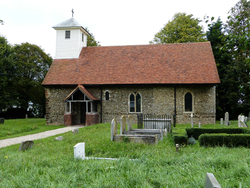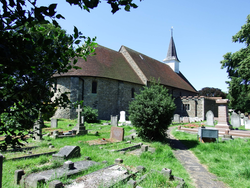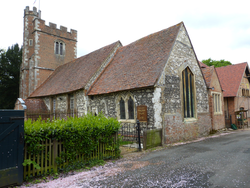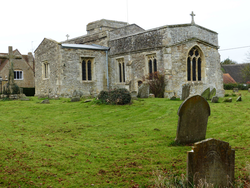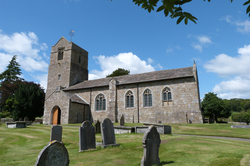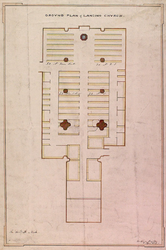
The Corpus of ROMANESQUE SCULPTURE in Britain & Ireland

St James the Less (now)
Parish church
Little Tey is a small village in the Colchester district of Essex, situated on the former Roman road of Stane Street (now the A120), some 6 miles W of Colchester. It is dwarfed by its neighbours, Marks Tey to the E and Great Tey to the N, and consists of little more than a few dwellings on a minor road that runs northwards from the A120 and peters out when it reaches the church.
St James’s is a small single-cell building of flint rubble with ashlar dressings and puddingstone quoiss. It has an apsidal E end; originally Norman but refenestrated in the early 14thc. Nave and chancel are decorated with an extensive series of 13thc wallpaintings of the Passion. There is a timber bell turret over the W end of the nave, and a S porch protecting a 12thc doorway – the only feature described here. The N doorway is now covered by a vestry.
Parish church
Hadleigh is a small town in the S of Essex that forms part of the conurbation that runs practically seamlessly from Southend-on-Sea in the E to Basildon in the W. Despite this it retains its own character, centred on the church of St James the Less that now occupies a large island in the A13. The church is substantially of the 12thc and consists of a chancel with an apsidal E end, the apse arch having been removed but the responds retained, while the 12thc chancel arch remains, flanked on the nave side by plain round arches. One plain 12thc window remains on the N chancel wall, while the apse has 3 segmental windows. The nave is tall with a W gallery housing the organ and 5 plain 12thc lancets remain in the side walls. The N and S nave doorways retain their round-headed rere arches, but the outer faces of both have been replaced. The S doorway is covered by a weatherboarded porch and the N by a large vestry, built in 1927 by Nicholson and now used as a kitchen and lavatory block. There is also a plain W doorway. There is no tower, but a 16thc weatherboarded bell turret with a slender broach spire is built over the W gable of the nave. The church is of rubble with clay tiled roofs. It was restored by G. E. Street in 1855-56.
Parish church
Dorney is a small village in the extreme south of the county, approximately a mile north of the Thames, which forms the border with Berkshire. Eton College is nearby, as is the rowing centre at Eton Dorney. The church stands in the grounds of Dorney Court, a manor house dating from the 15thc. St James’s consists of a 12thc nave with a brick S porch dated 1661, a 12thc chancel with a blocked round-headed window in the S wall, a 17thc north chapel containing the Garrard monument, and a brick west tower of the early 16thc. Inside the church is 16thc seating and a 17thc west gallery. Apart from the brick features, construction is of random rubble. The only feature recorded here is the 12thc font.
Parish church
Denchworth is a village in the Vale of the White Horse, 3 miles N of Wantage. The church is in the village centre alongside a moated site. It consists of a nave with 13thc. N aisle, chancel, S transept and NW tower all apparently post-12thc. Late 12thc. sculpture is found on the simple S nave doorway.
Parish church
Tatham is a village in the Lancaster district in NE Lancashire. A small church, no division between nave and chancel except for an external buttressing feature on the S wall which may represent the original rood staircase. Essentially the church appears to be a late medieval rebuild around a late C12 S door and N arcade piers, with subsequent tidying-up and heavy Victorian re-medievalisation. The tower, according to an inscribed stone in the N wall, was rebuilt in 1722, but probably incorporates medieval fabric.
The only Romanesque features now are the S door and possibly the piers, capitals and W respond of the arcade.
Parish church
The church, comprising a chancel, aisled central
tower, aisled nave and S porch, was rebuilt at the end
of the 13thc., but incorporates some reset 12thc. work. This includes the
moulded S doorway ofc.1200, earlier fragments of billet (chancel, int.; nave ext.) and
a voussoir (nave, ext.). The unusual font is probably
late 12thc. in date. The vestry was added in 1934.
